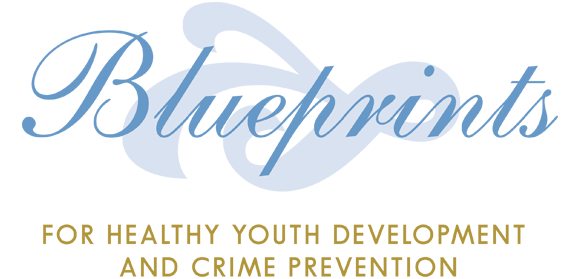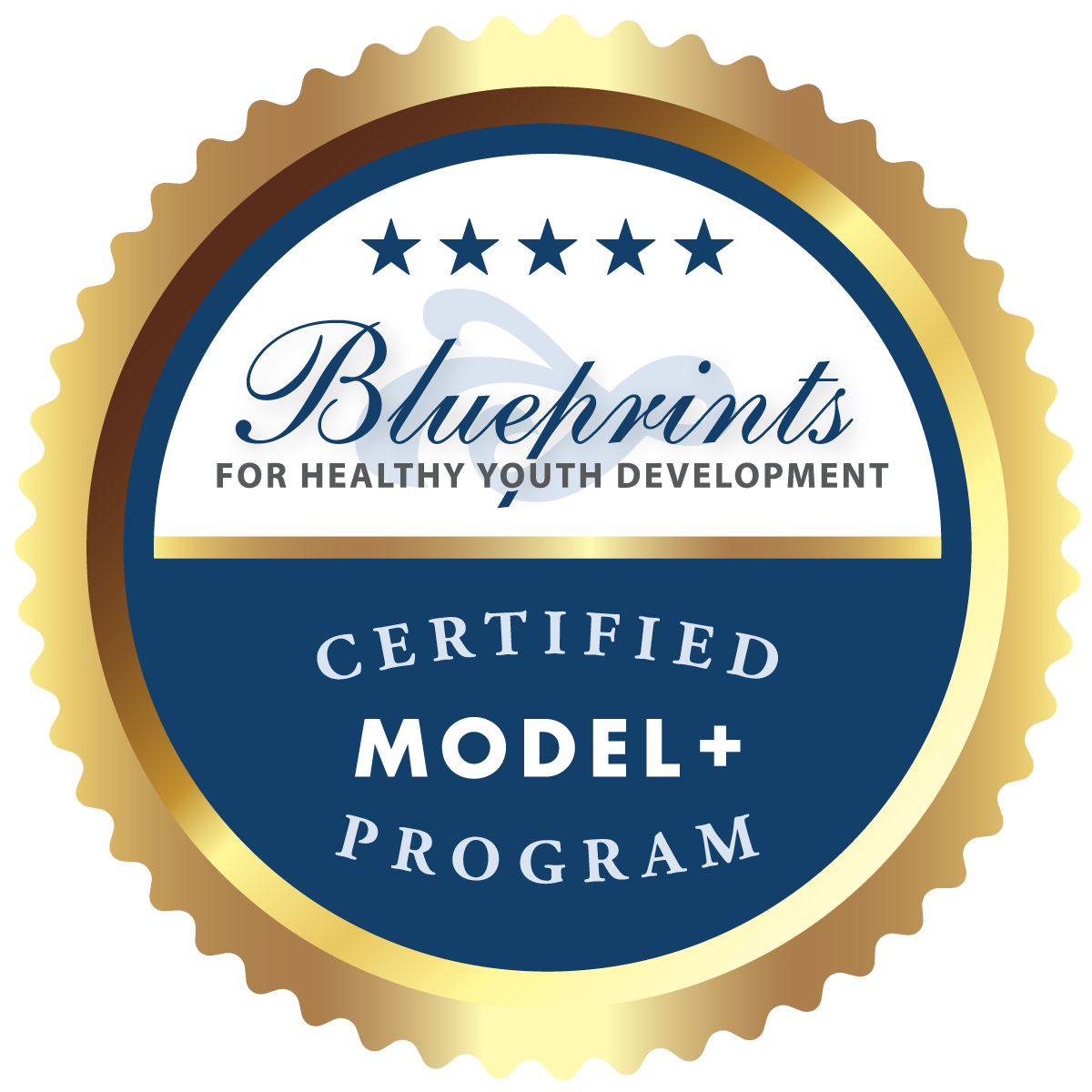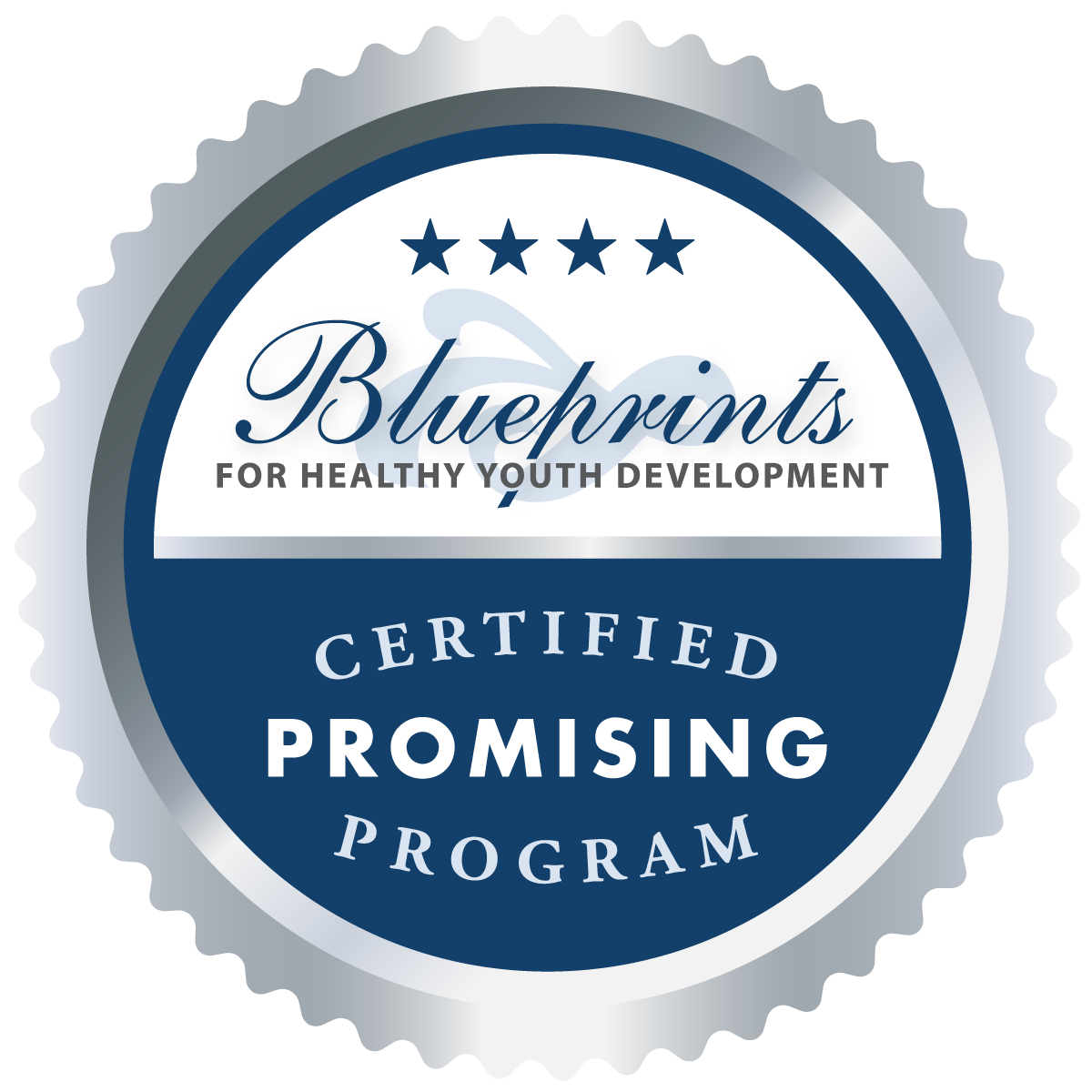
Program Search
This interactive search enables you to identify Blueprints-certified interventions based on specific criteria and then browse through a wide range of interventions that match those criteria. Select only a few criteria of importance, as the number of interventions may be reduced by selecting multiple items ACROSS categories, or increased by selecting multiple items WITHIN categories.
Model and Model Plus programs are listed separately from Promising programs. This is because only Model and Model Plus programs have demonstrated efficacy for changing outcomes over time and are recommended for large-scale implementation. Promising programs show promise of efficacy, but require follow-up research before being recommended for large-scale adoption.
23 Programs
| Program | Rating | Summary |
|---|---|---|
|
Brief Alcohol Screening and Intervention for College Students (BASICS)
|
 Model Plus
Model Plus
|
A brief motivational intervention for high-risk college students that uses alcohol screening and feedback to reduce problem, excessive, and binge drinking by enhancing motivation to change, promoting healthier choices, reviewing myths and facts about alcohol, and teaching coping skills to moderate drinking.
A brief motivational intervention for high-risk college students that uses alcohol screening and feedback to reduce problem, excessive, and binge drinking by enhancing motivation to change, promoting healthier choices, reviewing myths and facts about alcohol, and teaching coping skills to moderate drinking.
|
Target Population
Age: Early Adulthood (19-24) |
||
|
LifeSkills Training (LST)
|
 Model Plus
Model Plus
|
A classroom-based substance abuse prevention program designed to prevent teenage drug and alcohol abuse, tobacco use, violence and other risk behaviors by teaching students self-management skills, social skills, and drug awareness and resistance skills.
A classroom-based substance abuse prevention program designed to prevent teenage drug and alcohol abuse, tobacco use, violence and other risk behaviors by teaching students self-management skills, social skills, and drug awareness and resistance skills.
|
Target Population
Age: Early Adolescence (12-14) - Middle School |
||
|
Blues Program
|
 Model
Model
|
A school-based group intervention that aims to reduce negative cognition and increase engagement in pleasant activities to prevent the onset and persistence of depression in high school students exhibiting depressive symptoms. A school-based group intervention that aims to reduce negative cognition and increase engagement in pleasant activities to prevent the onset and persistence of depression in high school students exhibiting depressive symptoms. |
Target Population
Age: Late Adolescence (15-18) - High School |
||
|
Multisystemic Therapy - Problem Sexual Behavior (MST-PSB)
|
 Model
Model
|
A juvenile sex offender treatment program designed to reduce criminal and antisocial behavior, especially problem sexual behavior, by providing intensive family therapy services in the youth's natural environment over a 5-7 month period. A juvenile sex offender treatment program designed to reduce criminal and antisocial behavior, especially problem sexual behavior, by providing intensive family therapy services in the youth's natural environment over a 5-7 month period. |
Target Population
Age: Late Adolescence (15-18) - High School, Early Adolescence (12-14) - Middle School |
||
|
Positive Action
|
 Model
Model
|
A school-based social emotional learning program for students in elementary and middle schools to increase positive behavior, reduce negative behavior, and improve social and emotional learning and school climate.
A school-based social emotional learning program for students in elementary and middle schools to increase positive behavior, reduce negative behavior, and improve social and emotional learning and school climate.
|
Target Population
Age: Early Adolescence (12-14) - Middle School, Late Childhood (5-11) - K/Elementary |
||
|
Project Towards No Drug Abuse
|
 Model
Model
|
A high school classroom-based drug prevention program that aims to prevent teen drinking, smoking, marijuana, and other hard drug use. A high school classroom-based drug prevention program that aims to prevent teen drinking, smoking, marijuana, and other hard drug use. |
Target Population
Age: Late Adolescence (15-18) - High School |
||
|
Strong African American Families Program
|
 Model
Model
|
An interactive educational program for African American parents and their early adolescent children living in rural communities that is designed to strengthen family relationships and help adolescents develop positive behaviors and respond effectively to the risks of substance use, delinquency, and sexual involvement. An interactive educational program for African American parents and their early adolescent children living in rural communities that is designed to strengthen family relationships and help adolescents develop positive behaviors and respond effectively to the risks of substance use, delinquency, and sexual involvement. |
Target Population
Age: Early Adolescence (12-14) - Middle School, Late Childhood (5-11) - K/Elementary |
||
|
Treatment Foster Care Oregon
|
 Model
Model
|
A therapeutic foster care program with the goal of reuniting families, reducing delinquency and teen violence, and increasing prosocial behavior and participation in prosocial activities through behavioral parent training and support for foster parents, family therapy for biological parents, skills training and supportive therapy for youth, and school-based behavioral interventions and academic support.
A therapeutic foster care program with the goal of reuniting families, reducing delinquency and teen violence, and increasing prosocial behavior and participation in prosocial activities through behavioral parent training and support for foster parents, family therapy for biological parents, skills training and supportive therapy for youth, and school-based behavioral interventions and academic support.
|
Target Population
Age: Late Adolescence (15-18) - High School, Early Adolescence (12-14) - Middle School |
||
| Program | Rating | Summary |
|---|---|---|
|
Big Brothers Big Sisters of America
|
 Promising
Promising
|
A community mentoring program which matches a volunteer adult mentor to a child or adolescent to delay or reduce antisocial behaviors; improve academic success, attitudes and behaviors, peer and family relationships; strengthen self-concept; and provide social and cultural enrichment. A community mentoring program which matches a volunteer adult mentor to a child or adolescent to delay or reduce antisocial behaviors; improve academic success, attitudes and behaviors, peer and family relationships; strengthen self-concept; and provide social and cultural enrichment. |
Target Population
Age: Late Adolescence (15-18) - High School, Early Adolescence (12-14) - Middle School, Late Childhood (5-11) - K/Elementary |
||
|
Communities That Care
|
 Promising
Promising
|
A prevention system designed to reduce levels of adolescent delinquency and substance use through the selection and use of effective preventative interventions tailored to a community's specific profile of risk and protection.
A prevention system designed to reduce levels of adolescent delinquency and substance use through the selection and use of effective preventative interventions tailored to a community's specific profile of risk and protection.
|
Target Population
Age: Early Childhood (3-4) - Preschool, Infant (0-2), Early Adulthood (19-24), Late Adolescence (15-18) - High School, Early Adolescence (12-14) - Middle School, Late Childhood (5-11) - K/Elementary |
||
|
Cooperative Learning
|
 Promising
Promising
|
A school-based intervention designed to provide youth with positive peer relationships that can promote positive behaviors, prevent bullying and victimization, and reduce emotional (mental health) problems and risky behaviors such as alcohol use. A school-based intervention designed to provide youth with positive peer relationships that can promote positive behaviors, prevent bullying and victimization, and reduce emotional (mental health) problems and risky behaviors such as alcohol use. |
Target Population
Age: Early Adolescence (12-14) - Middle School |
||
|
EFFEKT
|
 Promising
Promising
|
An alcohol prevention program designed to reduce teenage alcohol use through parent training.
An alcohol prevention program designed to reduce teenage alcohol use through parent training.
|
Target Population
Age: Early Adolescence (12-14) - Middle School |
||
|
Familias Unidas
|
 Promising
Promising
|
A family-based intervention to empower Hispanic immigrant parents to build a strong parent-support network and help their adolescent children respond effectively to the risks of substance use and unsafe sexual behavior. A family-based intervention to empower Hispanic immigrant parents to build a strong parent-support network and help their adolescent children respond effectively to the risks of substance use and unsafe sexual behavior. |
Target Population
Age: Late Adolescence (15-18) - High School, Early Adolescence (12-14) - Middle School |
||
|
Guiding Good Choices
|
 Promising
Promising
|
A family competency training program that aims to enhance parenting behaviors and skills, to enhance effective child management behaviors and parent-child interactions and bonding, to teach children skills to resist peer influence, and to reduce adolescent problem behaviors.
A family competency training program that aims to enhance parenting behaviors and skills, to enhance effective child management behaviors and parent-child interactions and bonding, to teach children skills to resist peer influence, and to reduce adolescent problem behaviors.
|
Target Population
Age: Early Adolescence (12-14) - Middle School |
||
|
InShape Prevention Plus Wellness
|
 Promising
Promising
|
A brief prevention program to improve physical, mental, and spiritual well-being of college students by connecting positive health habits and images with the avoidance of risky alcohol, tobacco, marijuana and other drug use.
A brief prevention program to improve physical, mental, and spiritual well-being of college students by connecting positive health habits and images with the avoidance of risky alcohol, tobacco, marijuana and other drug use.
|
Target Population
Age: Early Adulthood (19-24) |
||
|
Learning Together
|
 Promising
Promising
|
A whole-school program that aims to improve the school environment to reduce bullying and aggression, and promote student health and wellbeing. A whole-school program that aims to improve the school environment to reduce bullying and aggression, and promote student health and wellbeing. |
Target Population
Age: Early Adolescence (12-14) - Middle School |
||
|
PROSPER
|
 Promising
Promising
|
A delivery system that attempts to foster implementation of evidence-based youth and family interventions, complete with ongoing needs assessments, monitoring of implementation quality and partnership functions, and evaluation of intervention outcomes.
A delivery system that attempts to foster implementation of evidence-based youth and family interventions, complete with ongoing needs assessments, monitoring of implementation quality and partnership functions, and evaluation of intervention outcomes.
|
Target Population
Age: Early Adolescence (12-14) - Middle School |
||
|
Raising Healthy Children
|
 Promising
Promising
|
A preventive intervention with teacher, parent, and child components, designed to promote positive youth development by enhancing protective factors, reducing identified risk factors, and preventing problem behaviors and academic failure.
A preventive intervention with teacher, parent, and child components, designed to promote positive youth development by enhancing protective factors, reducing identified risk factors, and preventing problem behaviors and academic failure.
|
Target Population
Age: Late Adolescence (15-18) - High School, Early Adolescence (12-14) - Middle School, Late Childhood (5-11) - K/Elementary |
||
|
RealTeen
|
 Promising
Promising
|
An internet-based, gender-specific drug abuse prevention program intended to reduce substance use among early adolescent girls through improving personal, social, and drug refusal skills. An internet-based, gender-specific drug abuse prevention program intended to reduce substance use among early adolescent girls through improving personal, social, and drug refusal skills. |
Target Population
Age: Early Adolescence (12-14) - Middle School |
||
|
Self-Monitoring Alcohol And health Risks Tool (SMAART) App
|
 Promising
Promising
|
A program to reduce unhealthy alcohol use among college students through the use of a smartphone app. A program to reduce unhealthy alcohol use among college students through the use of a smartphone app. |
Target Population
Age: Early Adulthood (19-24) |
||
|
SPORT Prevention Plus Wellness
|
 Promising
Promising
|
A health promotion program that highlights the positive image benefits of an active lifestyle to reduce the use of alcohol, tobacco and drug use by high school students in addition to improving their overall physical health.
A health promotion program that highlights the positive image benefits of an active lifestyle to reduce the use of alcohol, tobacco and drug use by high school students in addition to improving their overall physical health.
|
Target Population
Age: Late Adolescence (15-18) - High School |
||
|
Strengthening Families 10-14
|
 Promising
Promising
|
A group parenting and youth skills program that aims to promote good parenting skills and positive family relationships; reduce aggressive, hostile behavior, and substance abuse in adolescence; and improve family relationships through weekly parent effectiveness training and child skills-building, followed by a family session.
A group parenting and youth skills program that aims to promote good parenting skills and positive family relationships; reduce aggressive, hostile behavior, and substance abuse in adolescence; and improve family relationships through weekly parent effectiveness training and child skills-building, followed by a family session.
|
Target Population
Age: Early Adolescence (12-14) - Middle School, Late Childhood (5-11) - K/Elementary |
||
|
Strong African American Families - Teen
|
 Promising
Promising
|
A family-centered group program for African-American teens living in rural communities that fosters skills for parenting, strengthens family relationships, and helps youth develop the self-regulation needed to respond effectively to risks of substance use and unsafe sexual behavior. A family-centered group program for African-American teens living in rural communities that fosters skills for parenting, strengthens family relationships, and helps youth develop the self-regulation needed to respond effectively to risks of substance use and unsafe sexual behavior. |
Target Population
Age: Late Adolescence (15-18) - High School |
||
 Program
Program